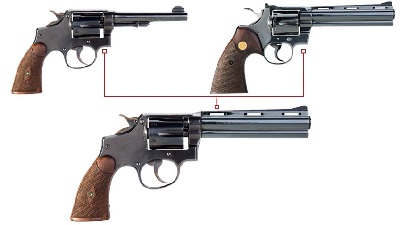 Sam Colt invented the revolver as we know it, offering the first one for sale in 1836. That first Paterson was a five-shot, cap-and-ball revolver. An earlier—and very complicated—flintlock revolver, the Collier, came out of the United Kingdom and may or may not have had some influence on the young Yankee entrepreneur. The gun’s introduction as a repeating handgun was a radical innovation, ideally suited for America’s westward expansion. Much of that movement was on horseback, where the one-handed repeater was ideal. Various models of the Colt revolver followed, each offering improvements of one kind or the other. There were many imitators, but Colt was pretty much the main firm through the end of the Civil War. Serious competition came when two guys named Smith and Wesson got their take on the revolver, which fired metallic cartridges, up and running with serious calibers. By the early 1870s, the two companies were building the majority of the fighting revolvers in active service. It was a fierce competition that continued for about a century.
Sam Colt invented the revolver as we know it, offering the first one for sale in 1836. That first Paterson was a five-shot, cap-and-ball revolver. An earlier—and very complicated—flintlock revolver, the Collier, came out of the United Kingdom and may or may not have had some influence on the young Yankee entrepreneur. The gun’s introduction as a repeating handgun was a radical innovation, ideally suited for America’s westward expansion. Much of that movement was on horseback, where the one-handed repeater was ideal. Various models of the Colt revolver followed, each offering improvements of one kind or the other. There were many imitators, but Colt was pretty much the main firm through the end of the Civil War. Serious competition came when two guys named Smith and Wesson got their take on the revolver, which fired metallic cartridges, up and running with serious calibers. By the early 1870s, the two companies were building the majority of the fighting revolvers in active service. It was a fierce competition that continued for about a century.
In the time of the Indian Wars, Smith & Wesson made some huge sales overseas, so the company’s revolvers were not that well-known in this country. Several of its guns—like the break-top Schofield—were used and respected. But this was a time when Colt pretty well ruled the roost with the Peacemaker in its many chamberings. Both companies offered double-action/single-action guns by the 1880s. Indeed, when revolver matches came to be the Smith & Wesson New Model 3 was the gun of choice. In the 1890s, both manufacturers developed revolvers in a format that we have come to regard as typical. It involved a solid (not hinged) frame with a cylinder that swung outward to the left. Trigger pressure would cause the hammer to come fully back, as the cylinder revolved around to index with the barrel. It was also possible to thumb-cock the hammer and then press the trigger to fire. The first is double-action, and the second is single-action. The two systems are often confused, but that’s an issue for another day.
My point is simply that by the turn of the century, both of America’s major handgun manufacturers made revolvers that looked quite similar, behaved much the same and even sold at roughly the same price. They fired the same cartridges and came in small, medium and large configurations. From that point in time forward to the 1970s, it was a battle for supremacy. One firm might be ahead in sales on the strength of a new innovation, as when Colt introduced an aluminum-frame revolver for concealed carry. It was quickly answered by a similar gun from Smith & Wesson. Interestingly enough, when the industry could not completely fill the need for 1911 semi-automatics in 1917, both Colt and Smith & Wesson quickly changed their large-revolver lines to build Model 1917 revolvers chambered in .45 ACP. Both companies were more than capable of offering upgraded revolvers for special purposes—the first Registered Magnums from Smith & Wesson as opposed to Colt’s Shooting Master revolvers in a significant amount of chamberings.
Was there any difference? Of course there were, but whatever differences there may have been, it did not relate to quality. Both companies made their guns in America, forged from steel smelted in this country and put together by Yankee craftsmen who took fierce pride in the product. There wasn’t a dime’s worth of difference in the fit and finish of the two makes. Once in a while, either of the two companies would get distracted and quality might suffer a bit, but that never lasted. Thus was the situation when I got involved with revolvers. That was 1969, when I became a deputy sheriff and carried a revolver by mandate from the department.

